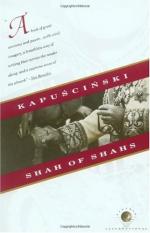|
This section contains 522 words (approx. 2 pages at 400 words per page) |

|
Shah of Shahs Summary & Study Guide Description
Shah of Shahs Summary & Study Guide includes comprehensive information and analysis to help you understand the book. This study guide contains the following sections:
This detailed literature summary also contains Topics for Discussion and a Free Quiz on Shah of Shahs by Ryszard Kapuściński.
Author Ryszard Kapuscinski provides personal reflections as well as a historical perspective on the 1979 Iranian revolution, in which Shah Mohammed Reza Pahlavi is forced from his throne and replaced by Supreme Leader Ayatollah Khomeini.
Kapuscinski begins the narrative well after the revolution has ended. He is trying to make sense of the various notes, interviews, and photographs he has collected during his time in Iran. Kapuscinski traces the lineage of Shah Mohammed Reza Pahlavi, the last Shah. His grandfather was a soldier who escorted the assassin of a Shah to a public execution. Pahlavi's father, Shah Reza Khan, is a huge and imposing man with a large appetite for life and possessions and an obsession with his military. Shah Reza Khan is forced from the throne during World War II by Allied forces after he refuses to allow goods to be shipped on Iran's Trans-Iranian railroad. At the age of twenty-two, Mohammed Reza Pahlavi, Reza Khan's son, becomes Shah.
Shah Pahlavi is an unsteady ruler, and in 1951 he is forced to flee the country after a popular revolt in which a liberal politician, Doctor Mossadegh, rises to Prime Minister and proceeds to nationalize Iran's oil. This is a disastrous move which is intolerable to the West, especially Britain, which has oil interests in the country. With the West's help, Mossadegh is forced down and the Shah resumes his monarchy after a few years in exile.
The Shah is an oppressive dictator, and his secret police, called Savak, terrorize citizens and cause much fear and unrest. This, along with a perception that the Shah is a puppet of the West, causes calls for the Shah's ouster from Ayatollah Khomeini, whom many in the Shiite faith believe is the Twelfth Imam of prophecy, destined to lead the people of earth into a new era of religious devotion.
In December 1973, the Shah announces to the world that he is increasing the cost of Iranian oil, pocketing the profits for the monarchy. He begins an immense new initiative to modernize Iran and add infrastructure, called the Great Civilization. This movement causes further alienation among the common people, who do not understand and do not benefit from the Shah's ambitious plans. Though the Shah does accomplish certain goals, the experiment is largely a failed one, causing resentment and billions of wasted dollars.
The proper start of the Iranian Revolution is traced to January 8, 1978, in which a propagandistic article against Khomeini is published by the Shah in a government newspaper. This causes rioting in Khomeini's home town of Qom, in which five hundred people are killed by police. Rioting spreads to subsequent towns and finally to Teheran, the capital. The Shah only responds with more violence, perpetuating the anger and resentment. By February of 1979, after massive strikes, the Shah is deposed and Khomeini returns from exile to lead. Kapuscinski touches lightly upon the famous hostage crisis in which dozens of Americans are held hostage in the U.S. Embassy.
Kapuscinski ends with reflections that the revolutionary order is just as inept, wasteful, and ultimately as violent and fearmongering as the monarchy it has replaced.
Read more from the Study Guide
|
This section contains 522 words (approx. 2 pages at 400 words per page) |

|



